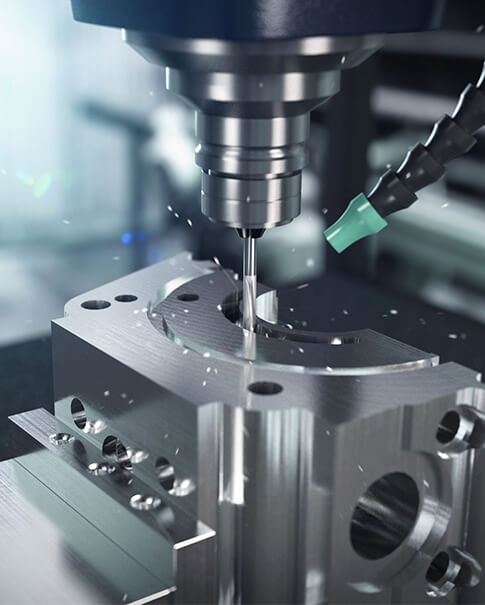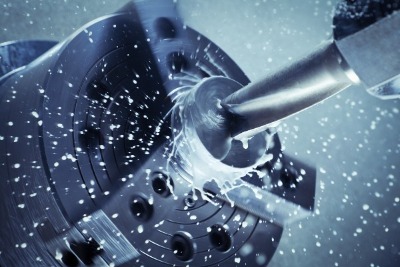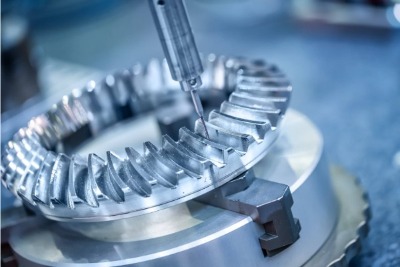
| Aerospace is a highly diverse industry comprising many sub-sectors, covering everything from commercial aviation to space exploration. This industry is consistently at the cutting edge of new manufacturing practices and technologies, with millions and millions of complex metal parts produced yearly. Its value as a global industry is estimated at around $900 billion. |  |
 |
Why does the aerospace industry use CNC machining?
While CNC machining is not the only manufacturing process used in aerospace, it may well be the most widely used. 3D printing is often used for lightweight components that aren’t crucial to system functions, like the 3D-printed polymer sensor covers for radiation monitors on the International Space System. For engine parts and other critical components, though, the only way to achieve the necessary tolerances is with CNC machining. Unlike other industries, the aerospace industry requires that dimensions, tolerances, and performance are the tightest and highest possible for every part. This is to ensure that these parts do not fail in flight.A single faulty or imperfect component can cause a loss of thousands of dollars in aircraft and space stations. Furthermore, poor production techniques often lead to huge safety risks to end-users. This is why aerospace machining companies work hard to meet all of these requirements. At the same time, they have to ensure that they produce aircraft quickly enough to meet market demands. |
|
5-axis machining in the aerospace industry Aerospace parts are most often highly complex. Most have odd geometries that require difficult approaches and sophisticated work-holding solutions. None, under any circumstances, can fail during use but are often made out of frangible or difficult-to-machine materials. Many are relatively large and need machines with huge work envelopes. The best way to solve these problems is by using multiaxis machining, namely 5-axis machining. 5 axis CNC machining involves the operation of a machine using highly accurate CNC. This process moves cutting tools and parts across up to 5 axes at the same time.The setup for the machine enables complex geometries. Since the aerospace industry continues to evolve, continuous reconfiguration and adaptation of parts are possible with 5 axis CNC machining. Generally, this robust process can cope better with the technicality and scope of aerospace components. Therefore, engineers can mill, drill, or manufacture them to the desired specifications of the aircraft. In addition, 5 axis machines meet the high-performance standards of aircraft CNC machining. |
 |
Materials Used in Aerospace CNC Machining
Aerospace was once dominated by low-cost, low-weight aluminum. While it is still used today, more composites and alloys are taking their places as go-to manufacturing materials. Materials of lower weights and higher temperature resistances are needed for engine parts and other components likely to endure high stresses during flight. A modern lean-burn engine can run as hot as 3,800°F (2,100°C) and must be made out of material that can withstand that.
Titanium alloys
No industry worldwide uses more titanium alloy than aerospace. Because the metal has an excellent strength-to-weight ratio, resists corrosion, and performs to a high standard at extreme temperatures. Titanium has become a staple material in aerospace production, and its use will increase still further over the next century.
Titanium aerospace parts include airframe and jet engine components, such as discs, blades, shafts, and casings. Many of these can be machined.
Aluminum alloys
Another widely used metal in aerospace machining — and one that has been around longer than titanium and modern composites — is aluminum.
Aluminum, for its part, is lighter than titanium but only about half as strong.The highly machinable metal is, however, more cost-effective than titanium.Aluminum forms an oxide coating when exposed to air, making it corrosion resistant, and it is also highly formable (more so than titanium), making it easy to CNC machine. It is also well-suited for a wide range of aircraft components.
High-Performance Plastics
In addition to metals like titanium and aluminum, aerospace machining can involve the use of high-performance plastics such as PEEK, polycarbonate, and Ultem. These materials are significantly more lightweight than metals. They help produce parts such as interior wall panels, ventilation ducts, aircraft doors, wiring conduits, bearings, and more. They are aerospace-grade plastics that are lightweight, strong, and meet aerospace fire retardant regulations.
Aerospace CNC Machining creates strong, lightweight, and complex plastic parts for the aerospace industry. Making these parts include such materials as PEEK and other high-performance polymers. Similar to working with metals, aerospace machining offers the high precision needed for polymer-based aerospace applications.
Conclusion
Precision machining is a vital aspect of the aerospace industry. This industry has loads of high production standards for CNC machining aerospace parts and more stringent safety controls.
Using state-of-the-art CNC machining equipment, qualified manufacturing services such as GT proto can produce aerospace prototypes and end-use components for aerospace companies. Working with aerospace-grade metals and plastics, CNC machine systems can reach tolerances up to 0.002 mm. Further, sophisticated post-processing and inspection systems can ensure that finished aerospace prototypes and parts are exactly up to standards.
At GT proto, our engineers meet the stringiest of industry standards to revolutionize the CNC machining process continually. Regardless of the tolerances you need for your CNC machining aerospace parts, our experts have the knowledge and experience to handle them. We have an excellent record for providing our customers with the highest possible precision.We are ready to work with you on every detail to ensure that the end product fits your unique requirements.